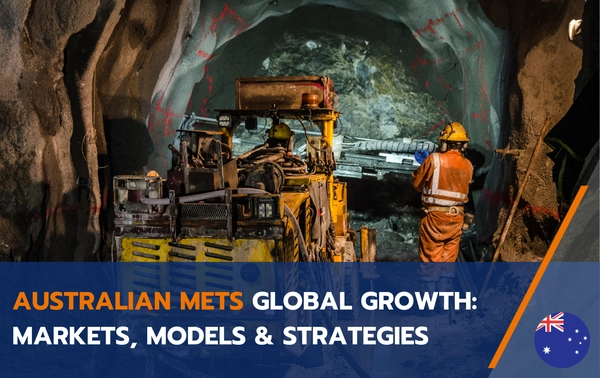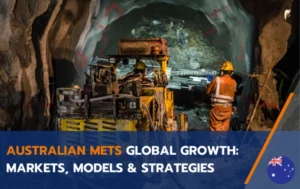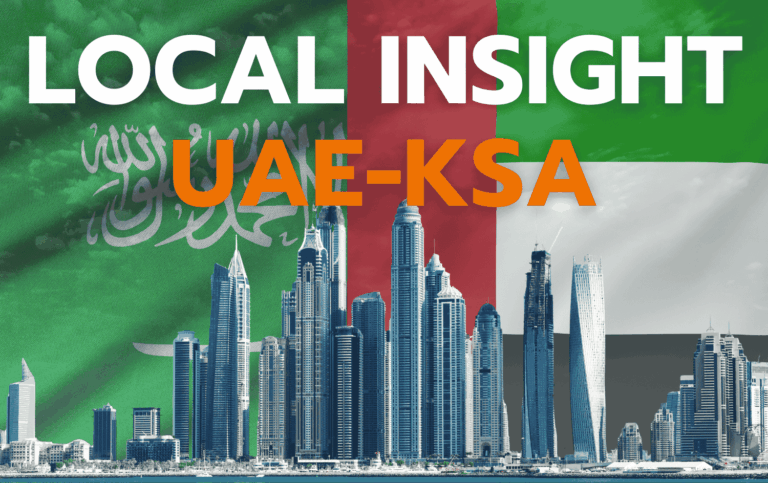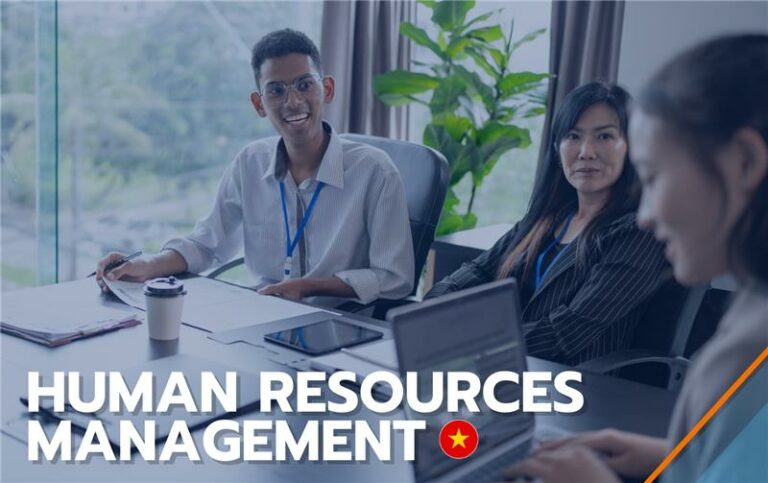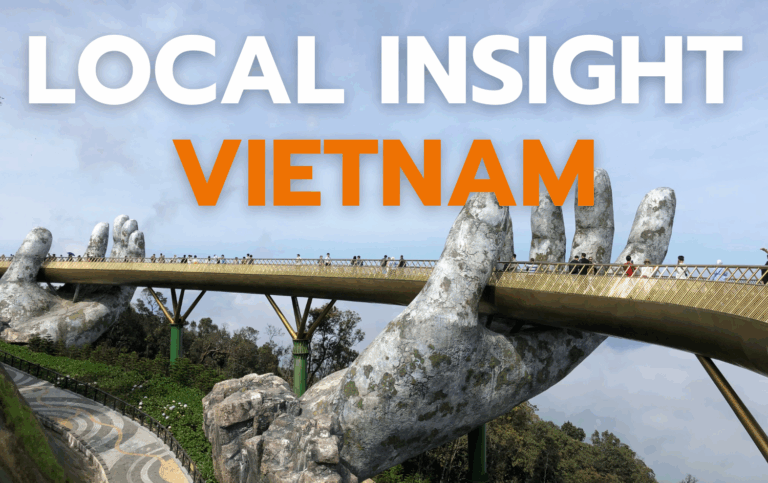Executive Summary
Australia’s Mining Equipment, Technology and Services (METS) sector stands at a critical juncture in its global development. With worldwide mining undergoing transformation driven by energy transition, supply chain diversification, and ESG imperatives, international demand for innovative METS solutions is accelerating. This paper provides a strategic roadmap for Australian METS companies to successfully expand internationally, prioritize high-return markets, and select optimal market entry models.
Introduction: The Strategic Imperative for Global Expansion
The global mining equipment market is projected to grow at a compound annual rate of approximately 5.1-5.7% between 2025 and 2030, with the Asia Pacific region specifically showing a higher growth rate of around 6.5%. Recent industry reports estimate the global mining equipment market will reach between USD 150 billion and USD 232 billion by 2032, depending on the source and forecast methodology. This variance reflects differences in market definitions and the inclusion of various equipment categories. This growth is particularly strong in the Asia Pacific region, with notable development in Indonesia and other markets modernizing their industrial infrastructure and implementing stricter environmental standards. While Latin America captures a significant portion of market value for mined output, specific country performance varies.
Australian METS firms are positioned to capitalize on this demand, with potential advantages including:
- Innovation capabilities in addressing mining challenges
- Adaptability to compliance requirements
- Access to international markets via Free Trade Agreements (FTAs)
In today’s shifting geopolitical landscape, international expansion has evolved from a growth option to a strategic necessity for companies seeking to remain competitive, mitigate concentration risk, and build sustainable scale.
Why International Expansion is Essential for METS Companies
For Australia’s METS sector, expanding internationally isn’t merely about increasing exports—it’s about future-proofing against market volatility, shifting trade policies, and over-reliance on legacy markets.
1. Shifting Global Demand
- The energy transition is driving record demand for critical minerals like lithium, nickel, and cobalt
- Emerging economies are ramping up mining activity, requiring advanced, ESG-compliant technologies
- New investments in infrastructure and processing capacity are fueling demand for modular, digital solutions
2. Trade Agreements Offer Competitive Access
| Trade Agreement | Partner Countries/Region | Key Benefits for METS Firms |
| AI-ECTA (Australia-India) | India | Eliminates tariffs on most METS exports; strategic access to India’s mining sector; entered into force December 29, 2022 |
| IA-CEPA (Indonesia-Australia) | Indonesia | Duty-free access; investment protections supporting complex market entry |
| CPTPP | 11 countries incl. Canada, Mexico, Chile, Vietnam | Tariff reductions across Asia-Pacific and Latin America; enables integrated supply chains; Australia’s implementation began December 30, 2018 |
| A-UKFTA | United Kingdom | Tariff-free trade; eases services access and labor mobility |
| EU Trade Framework | European Union (27 countries) | No FTA as of 2025; trade continues under WTO rules |
| AANZFTA | ASEAN + Australia, New Zealand | Harmonized rules across Southeast Asia; eases professional mobility |
| AUSFTA | United States | Preferential access, but new 2025 import tariffs (10%) may impact competitiveness |
| A-HKFTA | Hong Kong | Tariff-free access; strategic gateway to Mainland China |
3. Diversifying Beyond Traditional Powerhouses
- Anticipated 10% baseline import tariff in the US by 2025 may erode margins
- Ongoing complexities in Australia-China relations continue to create uncertainty
4. Sustaining Innovation Through Scale
- International markets provide test beds for new technologies and business models
- Unique regional challenges (high altitudes in Chile, regulatory complexity in South Africa) enable solution refinement and competitive differentiation
Key Insight for Decision-Makers: International expansion serves as a strategic hedge against market concentration, a mechanism to capitalize on global demand trends, and a foundation for long-term resilience in an increasingly fragmented economic landscape.
Potential Target Markets for Australian METS Firms (2025-2030)
Where to Go and Why: Considering Markets for Growth
Australian METS firms can respond to global mining challenges by focusing on regions with active mining sectors. Market selection should be guided by trade agreements, regulatory accessibility, and industry activity levels.
Potential Strategic Markets
| Market | Considerations |
| Indonesia | Demonstrated expansion in mining sector; IA-CEPA reduces trade barriers; strategic partnerships required for local compliance. |
| India | Mining sector development ongoing with AI-ECTA providing tariff reductions; potential for export opportunities. |
| Latin America Region | Captures a significant portion of market value for mined output; varying complexity in regulatory environments across countries. |
| Asia Pacific Region | Projected higher growth rate of approximately 6.5% compared to global average; varied market maturity levels. |
Additional High-Value Opportunities
| Market | Opportunity Snapshot |
| Canada | CPTPP membership offering tariff advantages; strong mining base and openness to digital and environmental innovations. |
| United States | Mature but competitive market; rising import tariffs present challenges, but specialized technologies and joint ventures can unlock value. |
| Saudi Arabia | Vision 2030 includes mining diversification; capital-intensive projects may require local presence and partnerships. |
| UAE | Commercial and logistics hub for Middle East and Africa; opportunities in innovation partnerships and supply chain integration. |
Market Selection Guidance:
Companies should conduct thorough market research to verify current conditions and opportunities in potential target markets. Success depends on aligning company capabilities with each market’s specific regulatory and commercial landscape, with careful attention to verified market data and trends.
International Expansion Models: Proven Approaches
1. Export-Led Growth in Tariff-Friendly Markets
Ideal for: Companies seeking quick entry without establishing a local presence
Best suited to: Canada, India, Mexico, UK
Key Characteristics:
- Benefits from tariff reductions under FTAs such as AI-ECTA and CPTPP
- Works well where trusted distributors or integrators can manage customer delivery and service
- Requires export-readiness planning, pricing strategy, and channel selection
How ALTIOS supports:
Firms can benefit from localized partner mapping, trade compliance advisory, and market validation to ensure their value proposition resonates before shipments begin.
2. Strategic Partnerships in Complex or Regulated Markets
Ideal for: Navigating markets with high compliance thresholds or complex governance
Best suited to: Indonesia, South Africa, Saudi Arabia, UAE
Key Characteristics:
- Involves co-development with local firms, public-private programs, or joint ventures
- Helps manage local content rules, certifications, and informal business practices
- Essential for building trust and accessing infrastructure projects
How ALTIOS supports:
Through on-the-ground business development teams, ALTIOS helps identify, vet, and initiate partnerships—streamlining negotiations and aligning with local regulatory norms.
3. Direct Investment and Local Presence in High-Barrier, High-Reward Markets
Ideal for: Mature companies with strategic long-term growth ambitions
Best suited to: Brazil, Chile, United States
Key Characteristics:
- Involves setting up subsidiaries, tech hubs, or service centers
- Enables full control over customer experience, pricing, and talent management
- Often tied to long-term public or private contracts
How ALTIOS supports:
Companies benefit from end-to-end support across subsidiary setup, compliance, recruitment, and post-entry management—ensuring their operations remain efficient and locally compliant.
Strategic Insight:
While each model offers a unique path to growth, many firms adopt a phased approach—starting with exports or partnerships before evolving toward deeper operational presence. Having the right local advisors and execution partners in place can accelerate this transition while mitigating risk.
Navigating Common Internationalization Challenges
1. Regulatory Complexity and Local Content Requirements
In resource-rich markets, mining operations are subject to evolving regulations. Foreign vendors may need to meet local sourcing thresholds or secure sector-specific licenses.
Key Considerations:
- Understand national policies around local content requirements
- Build flexibility into timelines to accommodate administrative delays
- Monitor legal changes affecting import rules or tender eligibility
2. Logistics and Infrastructure Constraints
Geographical challenges can impact cost-to-serve and competitiveness—particularly in remote or landlocked regions.
Key Considerations:
- Assess infrastructure readiness when scoping new markets
- Evaluate the need for local inventory or technical service capabilities
- Plan for longer lead times and additional transport costs for complex systems
3. ESG Expectations and Compliance Pressure
International buyers and governments increasingly scrutinize ESG practices. METS providers must demonstrate compliance with both local and global standards.
Key Considerations:
- Integrate ESG performance into core offerings
- Ensure responsible sourcing and supply chain transparency
- Understand host country requirements for community engagement and environmental reporting
4. Currency Volatility and IP Protection Risks
New jurisdictions expose companies to financial and legal risks that can erode value.
Key Considerations:
- Account for exchange rate fluctuations in pricing models
- Safeguard intellectual property through local legal instruments
- Avoid arrangements where technology transfer is inadequately protected
Key Takeaway: Successful international expansion requires preparation beyond technical excellence. Careful market assessment, risk mapping, and scenario planning create the foundation for resilient global operations.
Tools and Resources for METS Exporters
1. Export Market Development Grants (EMDG)
Administered by Austrade, EMDG reimburses eligible exporters for international marketing and promotional costs.
Use Cases:
- Market research and feasibility studies
- Trade shows and in-market visits
- Digital campaigns targeting offshore buyers
Good to Know:
- Applications require an approved export plan
- Funding operates on a tiered model based on export maturity
2. Free Trade Agreements (FTAs)
Australia’s FTA network offers tariff relief and improved access conditions across goods, services, and investment.
Use Cases:
- Reduced duties on machinery and modular systems
- Simplified customs procedures
- Stronger IP protection in certain jurisdictions
Good to Know:
- FTAs vary significantly; review agreement-specific rules of origin
- Combining FTA benefits with market intelligence enhances competitiveness
3. Government-Led Export Programs and Accelerators
Programs like Austrade’s Landing Pads and bilateral innovation platforms support technology validation abroad. The METS Ignited program, which was active for eight years, may have recently concluded. Companies should verify the current status through official channels before relying on its support
Use Cases:
- Securing early adopters or co-development partners
- Fast-tracking local approvals or certifications
- Leveraging government credibility in regulated sectors
Good to Know:
- Participation requires a clear market entry plan
- These platforms can test new business models before full market entry
4. International Trade Finance and Risk Insurance
Solutions through Export Finance Australia and private insurers protect against payment defaults and finance overseas contracts.
Use Cases:
- Working capital for large international tenders
- Payment risk insurance for emerging markets
- Project finance for equipment installations abroad
Conclusion and Strategic Takeaways
Scaling Internationally with the Right Partner by Your Side
Australian METS companies stand at a pivotal moment. As global demand for critical minerals accelerates and ESG compliance becomes a business imperative, the opportunity for international growth has never been stronger—or more complex.
Success in global markets demands more than technical excellence. It requires a well-orchestrated strategy, on-the-ground execution, and trusted local relationships. Many companies struggle not because they lack ambition, but because they lack the cross-border visibility, operational infrastructure, and guidance needed to deliver.
This is where ALTIOS makes the difference.
Why Leading METS Companies Choose ALTIOS
With operations in over 24 countries and a dedicated team of international business advisors, ALTIOS delivers end-to-end support tailored to the unique challenges of the METS sector.
Strategic Insight, Built for Global Mining
- Market assessments with procurement visibility and competitor benchmarking
- Go-to-market strategies aligned with ESG priorities and local buyer expectations
- Market sizing, partner mapping, and phased internationalization roadmaps
Reliable Execution for Global Operations
- Subsidiary setup with full legal, tax, and regulatory compliance
- Cashflow and financial management tailored to international project timelines
- Talent acquisition and HR compliance for local technical teams
- Logistics planning for equipment deployment and aftersales support
Accelerated Growth Through Trusted Networks
- Identification and qualification of local partners and integrators
- Structured partnerships with governance frameworks and KPI alignment
- Contract negotiation support and IP protection in regulated markets
Your International Strategy, Delivered
Whether you’re entering India with a modular technology platform, establishing ESG partnerships in Chile, or setting up a regional hub in North America, ALTIOS provides the structure, insight, and operational support to make it happen.
When you’re ready to take your METS business global, ALTIOS is ready to lead the way.

